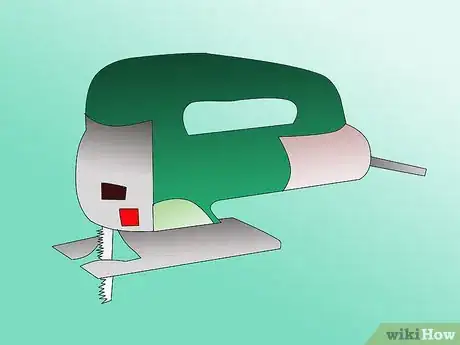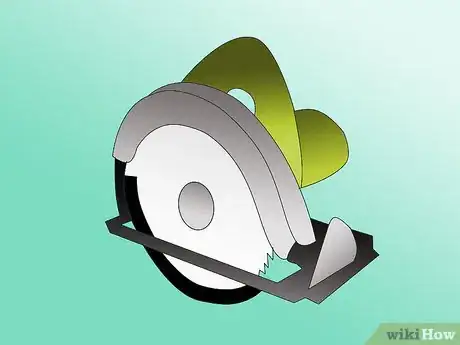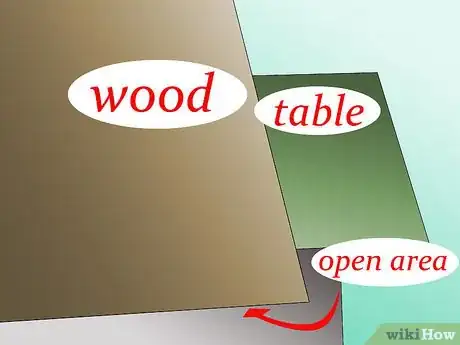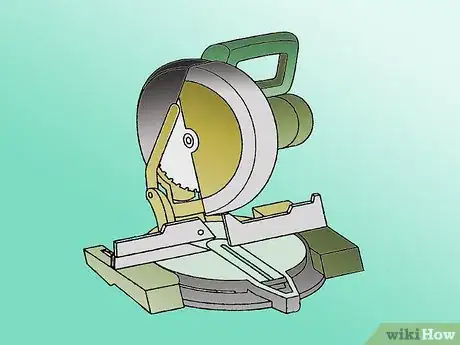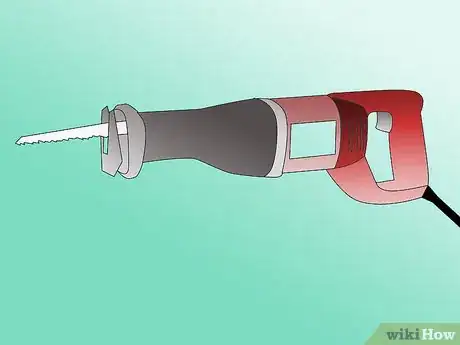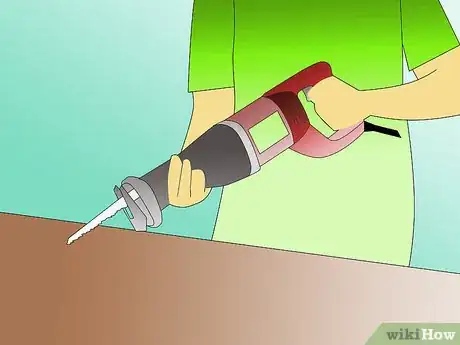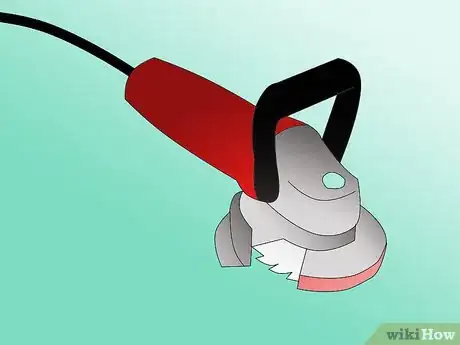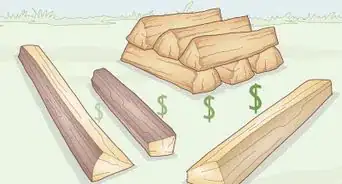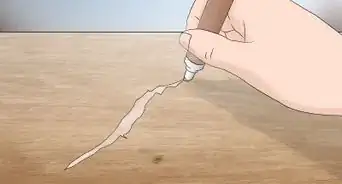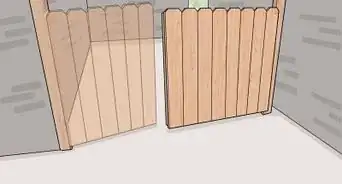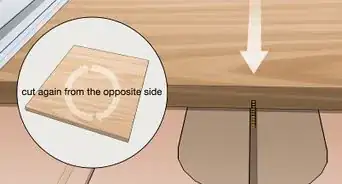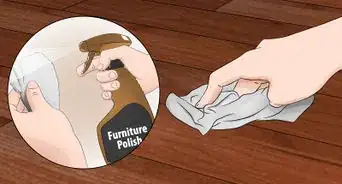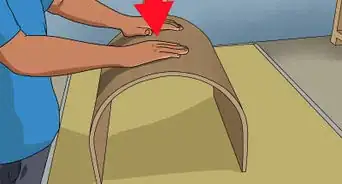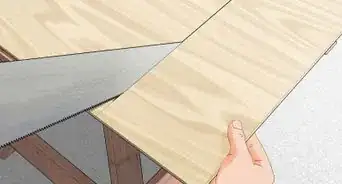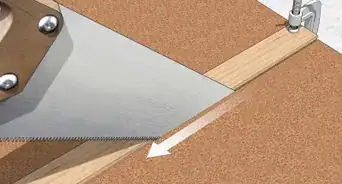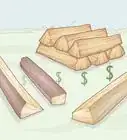This article was co-authored by Lui Colmenares. Lui Colmenares is a handyman and licensed home improvement contractor for Mr. Handy NYC based in New York City, New York. Lui is trained and educated as an industrial engineer and specializes in carpentry, painting, and general handyman work such as mounting TVs, doorknob and deadbolt installation, furniture assembly, tile repair, and grouting. Mr. Handy NYC prides itself on quality work performed with speed, skill, and punctuality.
There are 10 references cited in this article, which can be found at the bottom of the page.
This article has been viewed 327,495 times.
Ever needed to know which type of saw does what job? Or even how to use it? Tools help make cutting through wood less complicated, quicker and more accurate. Provided they are utilized properly and carefully, they can be of enormous advantage when undertaking a new project with timber. There are a variety of various saws which can be used to cut wood. This quick article is full of tips to help you along the way and is a help guide to some of the types of saws available.
Steps
-
1Use a jigsaw.[1] Various blades might be fitted to suit different types of solid wood, such as plywood, chipboard as well as hardboard. Jigsaws are specifically suited to cutting timber. It can create straight or curved cuts.[2]
- When generating a cut, position the wood on the bench and make sure the cutting area is clear to make certain you don’t cut through anything you don’t want to.
- Cuts are made as the sharp edge rises upwards through the timber. Which means neatest side will be on the underside. Bear this in your mind while placing the particular timber for a cut, specially if chopping solid wood which has a coated or melamine surface.
- Jigsaws often have adjustable rates of speed and are available having an airborne dirt and dust removal ability and also variable base dish perspectives.
-
2Use a circular saw.[3] These are used for cutting timber, MDF, block board and ply board. It makes direct line cuts. Like with a jigsaw, the actual cut is done as the cutting blades rise up-wards through the timber, so the neatest side will be on the underneath.[4]
- When making a new cut, place the actual timber coated surface upon a bench and make sure the cutting area is clear to make sure you don’t cut through what you don’t mean to.
- Circular saws generally feature varying chopping capabilities, adjustable speeds, a variable line of cut indicator, a depth adjuster, a remote lower guard lift lever, a dust removal facility and safety switch. Various attachments as well as blades usually are obtainable.
- Circular saw accessories are also available, which may be fitted to the top of your electric drill.
- You can use circular saws while installing custom shelves, not cut to size.[5]
- Measure the length you have to cut.
- After that, wear goggles and use the circular saw.[6]
Advertisement -
3Use a mitre saw.[7] This is used for all types of general-purpose joinery, such as chopping skirting planks, dado rails and architraves. It can make virtually any cut when a specific angle is essential, which includes angled and titled cuts. A mitre saw is a ‘fixed’ saw meaning that it doesn’t need to be moved manually because it slices the actual wood. You must therefore consider extra care to never place your hands in the way when generating the cut.[8]
- To use a mitre saw, you should make certain that the timber you would like to cut is actually clamped tightly as even a tiny amount of movement can impact the cut as well as result in a poor joint.
- A mitre saw should be used with a saw stand or possibly a work table to support your timber and saw whilst you carry out the work.
- Chop saws are the simplest forms of mitre saws. These include a saw that's suspended above the actual timber on a hinge. To produce a cut you pull the saw straight down towards the timber. How big your blade determines the size of cut you can create.
- Sliding mitre saws tend to be more superior. As well as including the same capabilities as a chop saw, they also have a sliding feature in order that the saw can be slid along the rail or perhaps guide. What this means is they are often used to produce a much wider cut than a chop saw will make.
-
4Use a reciprocating saw.[9] Reciprocating saws are often used for demolition work instead of building work. This is because they are most suited to making quick and ‘rough’ cuts. They are not suitable for any sorts of accurate cutting. They're therefore normally used for jobs such as taking out old window frames or even cutting up tree roots. It makes rough, basic cuts - similar to the kind of cut a chain saw would likely create. Because of its shape, a reciprocating saw can often be used to make cuts in places that other power tools would be not able to accomplish.
- A reciprocating saw needs to be held in both of your hands when in use. Proper care has to be taken to keep your saw steady. Placing the end of the tool against the wood may help maintain it in place.
- When utilizing a reciprocating saw it is possible to find the blade caught in the timber, so you should take care to plan your cuts carefully and be sure that, wherever possible, your wood you might be cutting can not ‘close up’ around the blade. Lubricating the blade can also help.
- Reciprocal saws often have adjustable speed settings. Some are available with a blade change facility that doesn't require a different tool (while some need an Allen key). Several reciprocal saws feature an orbital blade motion which often can help make cutting faster.
- Cordless reciprocal saws are available, which may be a good choice for use in difficult-to-reach areas.
-
5Use a door trimming saw.[10] This is used for trimming the lower edges of doors whilst they're in position. It makes simple shaping cuts. A door trimming saw ought to be held in both hands and really should be used slowly and steadily.
- Your saw ought to be used when the door to be cut is shut. You need to push the actual saw gradually into the bottom of the door until the edge meets the door and won't allow you to push the saw any further forwards. You should then slide the saw very carefully along the fringe of the door with a steady speed, keeping the sole-plate in contact with the floor to guide you. You must stop prior to reaching the edge of the door to ensure you don't damage the frame. Your cut can then be finished while the door is open.
- The only distinction between different types of door trimming saws is the depth of cut and also height of the blade from the ground.
Community Q&A
-
QuestionAre there any saws that can cut plastic?
 Community AnswerYes, a jigsaw or Sawzall (reciprocating saw). The teeth on the blades must be plenty and fine (the more teeth the better) in order to prevent breaking/ripping the plastic.
Community AnswerYes, a jigsaw or Sawzall (reciprocating saw). The teeth on the blades must be plenty and fine (the more teeth the better) in order to prevent breaking/ripping the plastic. -
QuestionWhat is the best device to cut or shave off the edge of a cupboard to enlarge the area enough to slide in the refrigerator?
 Ashton GilmoreCommunity AnswerFirst, make sure that the side of the cabinet is thick enough to remove without ruining structural integrity. As for tools, I would use a combination of a plane and sandpaper (or electric planer and an orbital sander) to thin it down and smooth it.
Ashton GilmoreCommunity AnswerFirst, make sure that the side of the cabinet is thick enough to remove without ruining structural integrity. As for tools, I would use a combination of a plane and sandpaper (or electric planer and an orbital sander) to thin it down and smooth it. -
QuestionHow do I cut a board to make it 2 1/2" wide on one end and 3" wide on the other end while making a perfectly straight cut?
 Community AnswerMark the different measurements on either end of the board, then clamp a straight edge on both marks. Use a circular saw along the edge for a straight cut.
Community AnswerMark the different measurements on either end of the board, then clamp a straight edge on both marks. Use a circular saw along the edge for a straight cut.
Warnings
- Tools can be quite dangerous if they're not used correctly. When you use power tools it is important to completely focus purely on the job at hand and be sure you aren't sidetracked while operating any powered equipment.⧼thumbs_response⧽
References
- ↑ https://www.familyhandyman.com/tools/woodworking-tools/how-to-use-a-jigsaw/
- ↑ https://www.bobvila.com/articles/how-to-use-a-jigsaw/
- ↑ https://www.popularmechanics.com/home/tools/a9183/circular-saw-tips/
- ↑ https://www.familyhandyman.com/tools/circular-saws/circular-saw-tips-and-techniques/
- ↑ https://abeautifulmess.com/how-to-build-custom-shelves/
- ↑ https://approachms.com/circular-saw-safety/
- ↑ https://www.familyhandyman.com/tools/miter-saws/how-to-use-a-power-miter-saw/
- ↑ https://www.lowes.com/n/how-to/how-to-use-a-miter-saw
- ↑ https://www.familyhandyman.com/tools/saws/reciprocating-saw-uses/
